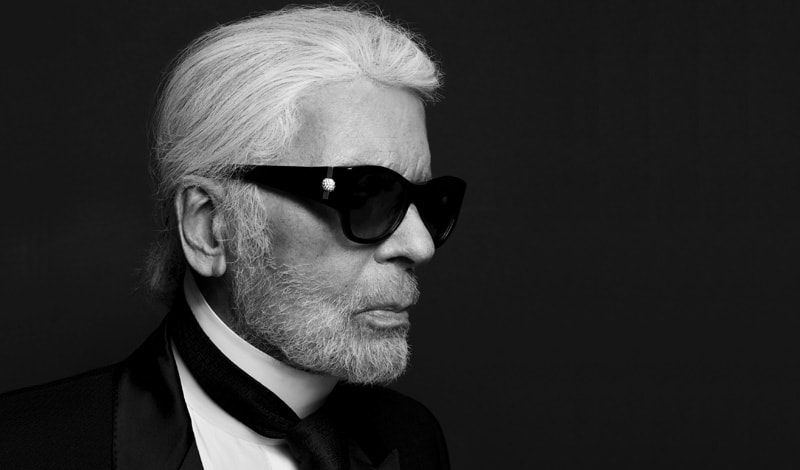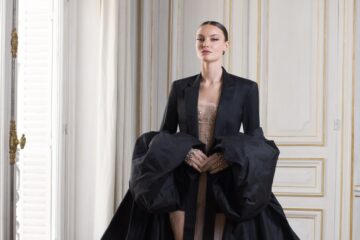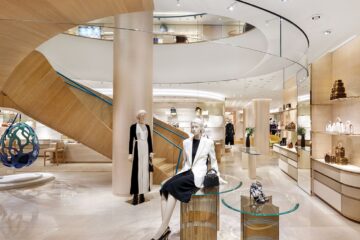The Catwalk Kaiser: The Life and Times of Fashion Icon Karl Lagerfeld
At the helm of Chanel for over three decades, Karl Lagerfeld was unrivalled in the fashion industry and created a legacy for himself that will not soon be forgotten.
WRITTEN BY JAN JANSSEN
On February 19, we saw the passing of one of the greatest icons in the history of design, Karl Lagerfeld. He was the high priest of fashion, and his death at the (reported) age of 85 sent shockwaves around the world, making front-page headlines on every continent. German TV devoted an hour-long special to him following his passing, and French TV networks similarly devoted several hours of programming to the legendary master of clothing design.
So immense was Lagerfeld’s impact on the popular imagination that his absence leaves a gaping hole in an industry that has lost his charismatic, self-styled trademark presence as a global ambassador for fashion. In keeping with the audacity of his designs, Lagerfeld succeeded in cultivating a highly identifiable public persona.
A skilled self-promoter à la Alfred Hitchcock’s shadow profile or Andy Warhol’s spiky silver wig, Lagerfeld was inextricably linked to his own self-mocking personal style conceits. The powdered hair, the dark glasses, the Hilditch & Key high-collared shirts, the tailored black jacket and skinny black jeans, the fingerless gloves and the boots — these were all part of Lagerfeld’s irreverent way of branding himself.
Having ruled the House of Chanel for more than three decades, the German wunderkind established himself as the dominant force in an industry given to sharp swings in public tastes. He was as inspired as he was tireless, a frenetic designer responsible for 17 collections a year that included Chanel, Fendi and his own Lagerfeld line. No one in the history of fashion has come close to matching the breadth of his creativity, even though he typically liked to dismiss his “workaholic” image.
“I hate that expression. I’m lucky that I can do what I like to do. I hate the idea of work. Work is when you have a boring job to make a living. That’s work … Please don’t say I work hard,” Lagerfeld scoffed. “Nobody is forced to do this job, and if they don’t like it, they should do another one. If it’s too much, do something else. But don’t start doing it and then say, ‘Aaah, it’s too much.’ Because a lot of people depend on it.”
“What we do at Chanel, thousands of people work on these things; these things are sold in hundreds and hundreds of shops all over the world. People like the big machine, and the money the big machine involves, but the effort … Then, suddenly, they become artists. They are too weak. Too fragile. Non. We have to be tough. We cannot talk about our suffering. People buy dresses to be happy, not to hear about somebody who suffered over a piece of taffeta. Me, I like to make an effort. I like nothing better than concrete reality. I’m a very down-to-earth person, but it is my job to make that earth more pleasant.”
Lagerfeld deserves to be remembered as a creative force of nature whose genius came to dominate a highly competitive industry that is by definition in a constant process of renewal and reinvention. When we think of artists such as Pablo Picasso, Ernest Hemingway, Ingmar Bergman, Vladimir Horowitz or Henri Cartier-Bresson, they should all be seen as “outliers” — individuals whose body of work was of unparalleled depth and scale. But while our collective memory of many such great artists tended to fade over time, even while they were still alive, Lagerfeld remained active and vital to the very end. Fashion may be ephemeral, but no designer was better able to stay on the cutting edge than King Karl.
Despite working in an industry known for its frivolous and arguably effete nature, Lagerfeld was rigorous, serious and dedicated to ensuring that his massive output did nothing to diminish his own high standards. Most fashion critics have long hailed him for the consistent quality of his clothes and his ability to stay relevant when so many designers go in and out of fashion.
“You can’t borrow on your past,” he declared. “Success nullifies — you have to do it again, and better … There is a very famous Jewish-German dictum that I love: ‘There is no credit on the past.’ So I’d better work now, huh!?”
A Lagerfeld fashion show (or défilé, as they say in Paris) was often an operatic event, where the creator descended from Mount Olympus to lecture ordinary mortals on the maintenance of divine standards. He once had a 265-tonne iceberg transported from Sweden for Chanel’s fall 2010 show at the Grand Palais in Paris, where he wanted to make a point about the dangers of climate change. “Global warming is the issue of our times. Fashion has to address it,” Lagerfeld stated.
Like Beethoven, his fashion symphonies continue to stand the test of time, and we continue to worship at the altar of this self-styled, irreverent and eccentric man. Though he first made his name in the rarefied world of Parisian haute couture in the 1950s, Lagerfeld was not at all elitist when it came to design. He worked with the mass-market German clothing manufacturer H&M, as well as with trendy Italian designer Renzo Rosso of Diesel, with whom he collaborated on the enormously successful Lagerfeld Gallery by Diesel denim collection.
The Cult of Karl
For years he strutted around our consciousness in his habitual white ponytail (which he would continue to embellish into his 80s with baby powder because his real hair was “pee-pee yellow”), high-collared white starched shirts (he had more than a thousand in his collection, all made by Hilditch & Key), sunglasses, fingerless gloves, black suits, skinny black jeans and leather boots. It’s a look that suited the German fashion guru well, and one could be forgiven for making the pun that he is a man of the cloth, albeit “a defrocked one,” Lagerfeld quipped.
And in the style of a high priest, Lagerfeld was fond of making lofty, pithy and frequently scathing statements in keeping with his strict, no-nonsense manner.
“My mother always got straight to the point and didn’t waste time with any nonsense or irrelevancies,” Lagerfeld explained. “She taught me the art of being direct and not being burdened by useless sentiment or speculation. That is why I don’t believe in indulging in polite restraint or mindless generalities. I like to say what I think, rather than hiding behind a wall of silly chit-chat.”
He was born Karl Otto Lagerfeldt (he later dropped the “t” for the sake of simplicity) in Hamburg, Germany, in 1933 (according to baptismal registers); although, he later stated that his actual birth year is 1935. His father worked for the Carnation Milk company and made a sizable fortune producing powdered milk in Germany. This allowed young Karl to grow up as a spectacularly “spoiled” child who lived in an immense mansion filled with servants and nannies.
He spent most of his time living an isolated and bubble-like existence, reading classic works like War & Peace, and Buddenbrooks when he was eight years old, already a child prodigy. He was fluent in French and English as well as his native German by the age of six, having insisted that his parents give him private language tutors.
“My problem as a child was that I was bored to death because I wanted to be a grown-up person. My childhood was endless — from [age] eight to 18 felt like hundreds of years. Today, parents are too much on their children’s backs. They’re overcaring. Non. Children should be in the corner. I was always in the corner, reading or sketching. But I wanted to be there. That’s all I ever wanted to do.”
He lived like a young prince or Mozart, a boy of preternatural intellectual gifts who spent his entire days sketching and reading and living in his “highly active imagination.”
“When I was a child, I didn’t know you could make a living out of fashion. I had no plans, but I was always ready for the unexpected. All these things are really interesting. I’m interested in interior design. I’m interested in fashion. I’m interested in books.”
Said Lagerfeld: “As a child, I never played with [other] children. I did nothing else other than sketching and reading. I loved to sketch because at the beginning of my life, I wanted to become a cartoon artist. I had discovered a famous cartoon magazine from the 1900s in the attic of my parents’ house, and the cartoons were very, very beautifully drawn.”
He arrived in Paris as an ambitious teenager, determined to succeed in the fashion world. He first apprenticed to Pierre Balmain, where his talent flourished, and he was soon appointed as a full-fledged designer for Jean Patou. In the ’60s, he established himself as a highly sought-after freelance designer, who often worked for Chloé, eventually serving as the fashion house’s head designer in the ’70s.
FROM COCO TO KARL
But it was not until he was appointed head designer at Chanel in 1983, a decade after Coco Chanel’s death, that he was finally given the chance to realize his talent and ambition.
“People think it was a great honour. When I started, it was not a great honour. Many people had advised me, ‘Don’t touch it; it’s dead.’ But I liked the idea of going to Chanel because it was a challenge … When I took on Chanel, it was a sleeping beauty — not even a beautiful one. She snored.”
It was at Chanel that Lagerfeld soon emerged as a fashion icon. He not only resurrected a dying brand, but he also helped reinvigorate the international fashion scene and became famous for establishing the modelling careers of Claudia Schiffer and Kate Moss, who was the face of Chanel fragrances until 2005, when Moss was photographed sniffing cocaine.
One of Lagerfeld’s last muses, model Cara Delevingne, became the face of Chanel’s 2013 Cruise campaign, posing as a topless Marie Antoinette figure. She later strutted down the runway for Lagerfeld in Chanel’s spring 2014 Paris fashion week show.
“She’s a character,” Lagerfeld said. “She’s the Charlie Chaplin of the fashion world. She is kind of genius, like a character out of a silent movie. I would see her better in a silent movie than a talkie because she over-accents the movement. Girls admire her like they used to Kate Moss. They all want to be as free as her.”
After the show, she posted a photo on Instagram, kissing Lagerfeld’s cheek with the caption: “Love you @karllagerfeld you are the one and only!!!” Nonetheless, Lagerfeld indulged in his penchant for brutal honesty when he later stated: “I hate when people say (Delevingne) is the new Kate Moss. Kate is unique. Nobody wants to be the second anything. Kate is beyond anything.” He later added: “Kate is the free girl of our times … She was not living on Vichy water all her life.”
REMAKING HIS OWN IMAGE
While many fashionistas have been famous (or infamous) for their indulgence, Lagerfeld was given to eating lavish [meals] prepared by private chefs. Then, growing tired of his overweight appearance, he dropped 90 pounds by going on a crash diet that consisted of a strict limit of 900 calories per day while also drinking 19 cans of Diet Coke daily. It was a dramatic change he said he needed to make to change his body image and enable him to wear some of the clothes he admired by other designers.
“I lost weight to be a good clotheshorse again,” Lagerfeld explained. “I couldn’t wear any of the clothes that were all designed for slim boys, especially those by Hedi Slimane, who was doing the Dior Homme collections,” he said.
“I believe in reinventing and reimagining yourself as often as you need to. I sometimes think of myself as a complete improvisation”
“I was no longer satisfied with my body and I said to myself: ‘You work in fashion, and fashion means change. If you don’t like your image, you only have to change it … I think that, for women as well as men, fashion is the healthiest motivation for losing weight. It is not a good idea to wait until you are ill or unhappy before going on a diet. I wasn’t really giving in to a narcissistic impulse, either. It was time for a change, that was all.”
For the sake of his professional credibility, Lagerfeld believed that it was important “to be able to prove that I am capable of creating transformations, not only with my designs but also in my own appearance. The boots, the shirts, the black trousers — the whole panoply — represented a sort of camouflage. It worked perfectly, and I lived very well in those outfits — or, rather, behind them. The dark glasses, the fan — they were like a wall between the world and myself.”
SELF-MOCKING SENSIBILITY
Lagerfeld always loved the art that goes into fashion and enjoyed spending his days sketching, looking at material and thinking of new ways to cut fabric and create different looks with his designs. He was utterly unsentimental and sold off most of his former palatial residences, as well as his former family mansion in Hamburg.
“I love change — I’m attached to nothing,” was his mantra when it came to life. “I believe in reinventing and reimagining yourself as often as you need to. I sometimes think of myself as a complete improvisation, and I have several selves in which I live. I don’t want to be real in other people’s minds.”
In the last decade of his life, Lagerfeld saw his image turned into Karl dolls and various other variations and mock likenesses of a man revered as a god in the fashion world.
“It’s funny. This is not supposed to be taken seriously. I don’t take myself very seriously. Do you know they even make a Barbie dressed like me now? Not Ken, but Barbie, dressed like me. It’s a big compliment,” Lagerfeld laughed.
To the very end, this ultimate Renaissance man was still creating and working on new collections. Lagerfeld never had any doubts about his ability to invest himself fully in his work, whether it was his eight collections for Chanel, his three different signature Karl Lagerfeld lines, his prêtà-porter, his shoe lines, his collections for Fendi or his passion for photography, interior design and everything else.














































































No Comment